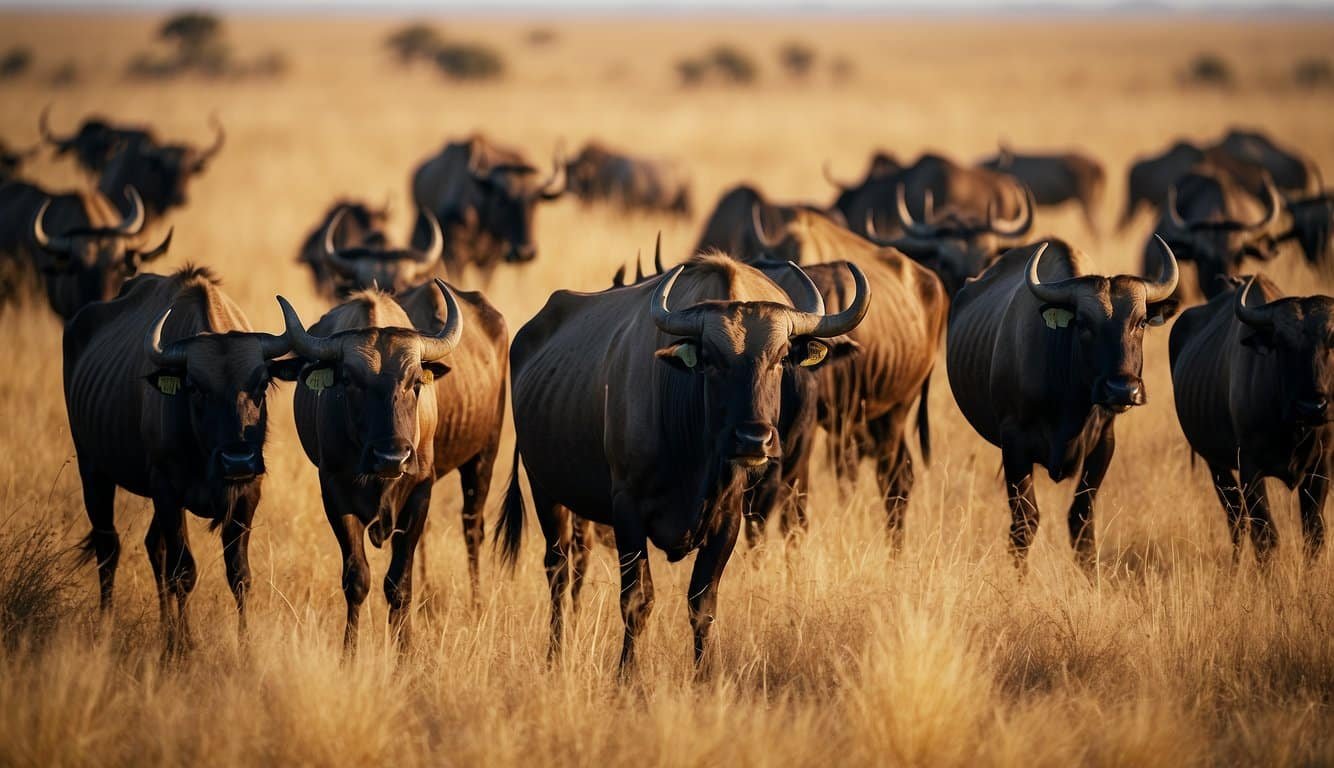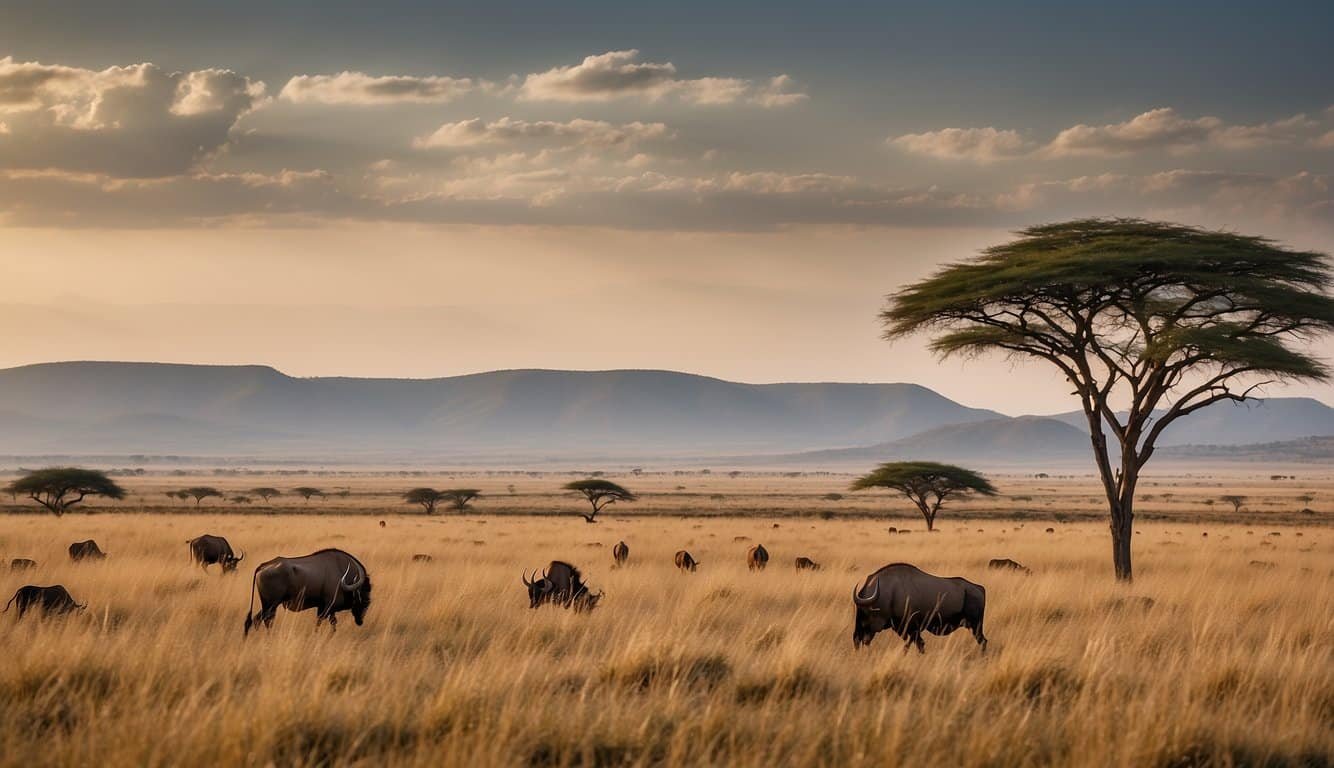Wildebeest Basics

Wildebeests, often known as gnus, are a sight to behold on the African savannah with their distinctive beards and prominent horns. These large antelopes are a blend of strength and stamina, fascinating to observe in their natural habitat.
Physical Characteristics
Wildebeests are robust animals characterized by a heavy build and a forward sloping stance. They sport a shaggy mane and a beard that can range in color from black to white. Males are typically larger than females, with adults weighing between 260 to 600 pounds. In terms of size, they can stretch up to 8 feet in length and stand 4.5 feet tall at the shoulder. Their horns are curved and can span up to 33 inches.
Species Variations
There are two main species of wildebeest: the blue wildebeest (Connochaetes taurinus) and the black wildebeest (Connochaetes gnou). While the blue wildebeest is more widespread, found throughout the grasslands and plains of eastern and southern Africa, the black wildebeest was historically confined to the southernmost parts of the continent. Blue wildebeests tend to have a silvery-blue sheen to their coats, which gives them their name. Black wildebeests are known for their white tail and the dark brown to black coats. Both species display social behavior, often seen grazing in mixed herds alongside zebras, impalas, and other herbivores.
Habitat and Distribution

The wildebeest, an iconic grazer, thrives across the vast savannas and grasslands of East and Southern Africa. These resilient animals play a critical role in their ecosystems, notably in the Serengeti and Maasai Mara regions.
Geographical Range
Wildebeest are predominantly found in the sprawling grasslands of Eastern and Southern Africa. In particular, Kenya and Tanzania are famous for the Serengeti ecosystem, which provides an ideal habitat for these animals. The wildebeest migration is a spectacular event here, with huge herds moving in a cyclical pattern across the Serengeti into Kenya’s Maasai Mara. Beyond this well-known area, wildebeest also roam the open plains of countries like Botswana, Angola, Zambia, Zimbabwe, Mozambique, and South Africa, indicating their adaptability across diverse African landscapes.
- East Africa: Serengeti, Maasai Mara
- Southern Africa: Botswana, Angola, Zambia, Zimbabwe, Mozambique.
Ecosystem Roles
Wildebeest are keystone species in their habitat, meaning their presence and behavior significantly shape the ecosystem. In the Serengeti National Park, they influence the distribution of other species, including predators and other grazers, through their migratory patterns and grazing habits. Their movements and feeding strategies can shape the vegetation structure of grasslands and savannas. Moreover, their migrating herds facilitate nutrient distribution across the regions they travel. The survival of predators, such as lions and hyenas, is closely tied to the availability of wildebeest as a food source in the African savanna ecosystem.
The ecosystem’s balance depends significantly on the wildebeest’s ability to roam freely across their natural habitat zones, making conservation efforts crucial for these vast African landscapes.
Behavior and Life Cycle
The wildebeest, also known as the gnu, exhibits remarkable behaviors and stages throughout its life cycle that are closely tied to the dynamic ecosystems they inhabit. These animals are known for their complex social structures and long-distance migrations, making their life story especially intriguing.
Social Structure and Reproduction
Wildebeest herds are predominantly composed of females and their young, with males establishing temporary territories during mating season. Reproduction is highly seasonal; the majority of calves are born during a short period following the rainy season, after a gestation period of approximately 8.5 months. This synchronicity in birth is a strategy to overwhelm predators like lions, hyenas, and cheetahs, as the abundance of calves leads to a higher chance of survival for the young.
Migratory Patterns
Migration is a defining characteristic of wildebeest behavior. These herds undertake a yearly migratory circuit of up to 1,000 miles in search of fresh grazing grounds, following the patterns of rainfall in the region. As they migrate, they often share territories with other grazing species such as zebra. Predators such as crocodiles and lions pose significant risks during migration, yet these herds persist, driven by the need to reach fertile grazing areas for their survival.
Engage further with the details of wildebeest migratory behavior through this detailed study, “Why are wildebeest the most abundant herbivore in the Serengeti ecosystem.” Additionally, insights into their social dynamics can be found in “The Gnu’s world: Serengeti wildebeest ecology and life history.”

